Root Canal Retreatment
Root Canal Retreatment
When a root canal treatment fails, the first course of action is to attempt to redo the root canal treatment. It is usually done by an Endodontist (root canal specialist) or an experienced general dentist.
Why do I need another endodontic procedure?
As occasionally happens with any dental or medical procedure, a tooth may not heal as expected after initial treatment for a variety of reasons:
1)
- Narrow or curved canals were not treated during the initial procedure.
- Complicated canal anatomy went undetected in the first procedure.
- The crown placement or other restoration was delayed following the endodontic treatment.
- The restoration did not prevent salivary contamination to the inside of the tooth.
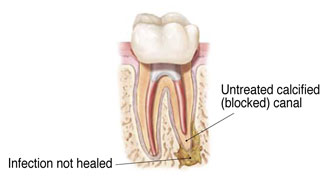
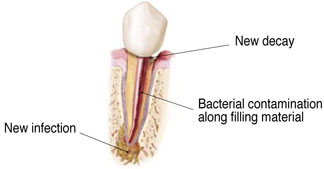
2)
In other cases, a new problem can jeopardize a tooth that was successfully treated. For example:
- New decay can expose the root canal filling material to bacteria, causing a new infection in the tooth.
- A loose, cracked, or broken crown or filling can expose the tooth to a new infection.
- A tooth sustains a fracture.
What will happen during retreatment?

The process is very similar to root canal treatment. The difference is that besides taking any remaining infected tissue out, the doctor has to take old filling material, any posts, crowns, or any other obstacle in the pulp space out to disinfect and seal the area of the root canal successfully.
First, the endodontist will discuss your treatment options. If you and your endodontist choose retreatment, the endodontist will reopen your tooth to gain access to the root canal filling material. Complex restorative materials—crown, post, and core material—must be disassembled and removed to permit access to the root canals.
After removing the canal filling, the endodontist can clean the canals and carefully examine the inside of your tooth using magnification and illumination, searching for any additional canals or unusual anatomy that requires treatment.
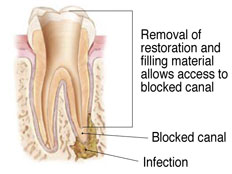
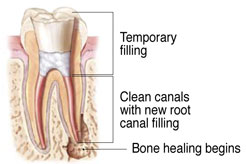
After cleaning the canals, the endodontist will fill and seal the canals and place a temporary filling in the tooth. If the canals are unusually narrow or blocked, your endodontist may recommend endodontic surgery. This surgery involves making an incision to allow the other end of the root to be sealed.
After your endodontist completes retreatment, you will need to return to your dentist as soon as possible to have a new crown or other restoration placed on the tooth to protect and restore it to its full function.
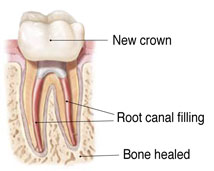
Is root canal retreatment the best choice for me?
Whenever possible, it is best to save your natural tooth. Retreated teeth can function well for years, even for a lifetime.
Technological advances are constantly changing the way root canal treatment is performed, so your endodontist may use new techniques that were not available when you had your first procedure. Your endodontist may be able to resolve your problem with retreatment.
As with any dental or medical procedure, there are no guarantees. Your endodontist will discuss your options and the chances of success before beginning retreatment.
How much will the procedure cost?
The cost varies depending on how complicated the procedure will be. The procedure will probably be more complex than your first root canal treatment because your restoration and filling material may need to be removed to accomplish the new procedure. In addition, your endodontist may need to spend extra time searching for unusual canal anatomy. Therefore, you can generally expect retreatment to cost more than the initial endodontic treatment.
While dental insurance may cover part or all of the cost for retreatment, some policies limit coverage to a single procedure on a tooth in a given period of time. Check with your employer or insurance company before retreatment to be sure of your coverage.
What are the alternatives to root canal retreatment?
If nonsurgical retreatment is not an option, then endodontic surgery should be considered. This surgery involves making an incision to allow access to the tip of the root. Endodontic surgery may also be recommended in conjunction with retreatment or as an alternative. Your endodontist will discuss your options and recommend appropriate treatment.
What are the alternatives to endodontic or root canal retreatment and/or endodontic surgery?
The only other alternative is the extraction of the tooth. The extracted tooth must then be replaced with an implant, bridge, or removable partial denture to restore chewing function and prevent adjacent teeth from shifting. Because these options require extensive surgery or dental procedures on adjacent healthy teeth, they can be far more costly and time-consuming than retreatment and restoration of the natural tooth.
No matter how effective tooth replacements are—nothing is as good as your natural tooth. You’ve already invested in saving your tooth. The payoff for choosing root canal retreatment could be a healthy, functioning natural tooth for many years to come.
Danville Office
Pleasanton Office
Hours of Operations
Monday-Friday: 8:00am - 5:00pm
Saturday-Sunday: Closed

